In brane cosmology, the velocity of the brane is a crucial parameter that describes the motion of the brane in the bulk space-time. This velocity is directly related to the scale factor of the universe, which in turn determines the expansion of the universe. Understanding how to calculate and measure the velocity of the brane is essential for understanding the dynamics of the universe in the context of brane cosmology.
Brane Cosmology and the Metric Tensor
In brane cosmology, the universe is described by a metric tensor that includes both the brane metric and the bulk metric. The brane metric is defined on the brane, while the bulk metric is defined in the bulk space-time. The metric tensor is used to calculate the scalar curvature, which is a measure of the curvature of the space-time. The scalar curvature is then used to derive the Friedmann equations, which describe the dynamics of the universe.
The Hubble Parameter and the Velocity of the Brane

The Friedmann equations can be written in terms of the Hubble parameter, which is defined as the derivative of the scale factor with respect to time. The Hubble parameter is a measure of the expansion rate of the universe, and it can be used to calculate the velocity of the brane.
Equation of Motion of the Brane
To find the velocity of the brane, we need to consider the equation of motion of the brane. The equation of motion of the brane can be derived from the action, which is a functional of the brane position and the metric tensor. The action is given by the Nambu-Goto action, which is a functional of the brane position and the induced metric on the brane.
Energy-Momentum Tensor and the Velocity of the Brane
The equation of motion of the brane can be written in terms of the energy-momentum tensor, which is a measure of the energy and momentum of the matter and radiation on the brane. The energy-momentum tensor can be written in terms of the energy density and the pressure of the matter and radiation on the brane.
Calculating the Velocity of the Brane
The velocity of the brane can be calculated from the equation of motion of the brane. The equation of motion of the brane can be written in terms of the Hubble parameter, the energy density, and the pressure of the matter and radiation on the brane. The velocity of the brane can be written as the derivative of the scale factor with respect to time, divided by the scale factor.
Theorem
The velocity of the brane can be calculated from the equation of motion of the brane, which can be derived from the action.
Physics Formula
The velocity of the brane can be written as the derivative of the scale factor with respect to time, divided by the scale factor:
$v = \frac{da}{dt} / a$
Physics Example
Consider a brane universe with a scale factor $a(t) = t^{2/3}$. The velocity of the brane can be calculated as:
$v = \frac{da}{dt} = \frac{2}{3}t^{-1/3}$
Physics Numerical Problem
Given a brane universe with a scale factor $a(t) = t^{2/3}$, calculate the velocity of the brane at $t = 1$ second.
Solution:
$v = \frac{da}{dt} = \frac{2}{3}t^{-1/3} = \frac{2}{3}(1)^{-1/3} = 0.63$ seconds$^{-1/3}$
Figure
The velocity of the brane as a function of time for a brane universe with a scale factor $a(t) = t^{2/3}$.
Data Points
The velocity of the brane at $t = 1, 2, 3, \dots$ seconds.
Values
$v(1) = 0.63, v(2) = 0.44, v(3) = 0.35, \dots$
Measurements
The velocity of the brane can be measured by observing the motion of galaxies and galaxy clusters, or by observing the cosmic microwave background radiation.
Conclusion
In summary, to find the velocity in brane cosmology, we need to consider the motion of the brane in the bulk space-time. The velocity of the brane can be related to the scale factor of the universe, which describes the expansion of the universe. The scale factor is a function of time and is related to the metric tensor, which describes the geometry of the space-time. The velocity of the brane can be calculated from the equation of motion of the brane, which can be derived from the action. The velocity of the brane can be measured by observing the motion of galaxies and galaxy clusters, or by observing the cosmic microwave background radiation.
Reference
- Strings, Branes and Extra Dimensions: Tasi 2001 (865 pages)
- Cosmology of brane universes and brane gases – Inspire HEP
- D-Brane inflation in the non-relativistic and relativistic … – AMS Tesi
- The Cosmological Constant – PMC – NCBI
- Brane Inflation and Cosmic String Tension in Superstring Theory

The lambdageeks.com Core SME Team is a group of experienced subject matter experts from diverse scientific and technical fields including Physics, Chemistry, Technology,Electronics & Electrical Engineering, Automotive, Mechanical Engineering. Our team collaborates to create high-quality, well-researched articles on a wide range of science and technology topics for the lambdageeks.com website.
All Our Senior SME are having more than 7 Years of experience in the respective fields . They are either Working Industry Professionals or assocaited With different Universities. Refer Our Authors Page to get to know About our Core SMEs.